DNA Barcoding for Identification of Consumer-Relevant Fungi Sold in New York: A Powerful Tool for Citizen Scientists?
Abstract
:1. Introduction
2. Materials and Methods
2.1. Study Limitations in Time, Funding, and Lab Access
2.2. Sample Collection
2.3. Generating DNA Barcodes
2.4. In Silico Species Identification
3. Results
4. Discussion
5. Conclusions
Supplementary Materials
Author Contributions
Funding
Acknowledgments
Conflicts of Interest
References
- What Every Member of the Trade Community Should Know about: Mushrooms. Available online: https://www.cbp.gov/sites/default/files/assets/documents/2016-Apr/icp007r2_3.pdf (accessed on 1 May 2017).
- Yahr, R.; Schoch, C.L.; Dentinger, B.T.M. Scaling up discovery of hidden diversity in fungi: Impacts of barcoding approaches. Philos. Trans. R. Soc. B Biol. Sci. 2016, 371, 20150336. [Google Scholar] [CrossRef] [PubMed]
- James, T.Y.; Kauff, F.; Schoch, C.L.; Matheny, P.B.; Hofstetter, V.; Cox, C.J.; Celio, G.; Gueidan, C.; Fraker, E.; Miadlikowska, J.; et al. Reconstructing the early evolution of Fungi using a six-gene phylogeny. Nature 2006, 443, 818–822. [Google Scholar] [CrossRef] [PubMed]
- Wu, D.-T.; Deng, Y.; Chen, L.-X.; Zhao, J.; Bzhelyansky, A.; Li, S.-P. Evaluation on quality consistency of Ganoderma lucidum dietary supplements collected in the United States. Sci. Rep. 2017, 7, 7792. [Google Scholar] [CrossRef] [PubMed]
- Moyer, D.C.; DeVries, J.W.; Spink, J. The economics of a food fraud incident—Case studies and examples including Melamine in Wheat Gluten. Food Control 2017, 71, 358–364. [Google Scholar] [CrossRef]
- Schwartz, J. Sushi Study Finds Deception. Available online: https://www.nytimes.com/2008/08/22/world/americas/22iht-fish.1.15539112.html (accessed on 1 May 2017).
- Little, D.P. Authentication of Ginkgo biloba herbal dietary supplements using DNA barcoding. Genome 2014, 57, 513–516. [Google Scholar] [CrossRef] [PubMed]
- Fišer Pečnikar, Ž.; Buzan, E.V. 20 years since the introduction of DNA barcoding: From theory to application. J. Appl. Genet. 2014, 55, 43–52. [Google Scholar] [CrossRef] [PubMed]
- Dentinger, B.T.M.; Suz, L.M. What’s for dinner? Undescribed species of porcini in a commercial packet. Peer J. 2014, 2, e570. [Google Scholar] [CrossRef] [PubMed]
- Bonney, R.; Cooper, C.B.; Dickinson, J.L.; Kelling, S.; Phillips, T.B.; Rosenberg, K. V; Shirk, J.L. Citizen Science: A Developing Tool for Expanding Science Knowledge and Scientific Literacy. BioScience 2009, 59, 977–984. [Google Scholar] [CrossRef] [Green Version]
- Xu, J. Fungal DNA barcoding. Genome 2016, 59, 913–932. [Google Scholar] [CrossRef] [PubMed] [Green Version]
- Jackson, C.J.; Barton, R.C.; Evans, E.G. Species identification and strain differentiation of dermatophyte fungi by analysis of ribosomal-DNA intergenic spacer regions. J. Clin. Microbiol. 1999, 37, 931–936. [Google Scholar] [PubMed]
- Eberhardt, U. Methods for DNA barcoding of fungi. Methods Mol. Biol. 2012, 858, 183–205. [Google Scholar] [CrossRef] [PubMed]
- Seifert, K.A. Progress towards DNA barcoding of fungi. Mol. Ecol. Resour. 2009, 9, 83–89. [Google Scholar] [CrossRef] [PubMed] [Green Version]
- Hebert, P.D.N.; Cywinska, A.; Ball, S.L.; DeWaard, J.R. Biological identifications through DNA barcodes. Proc. R. Soc. B Biol. Sci. 2003, 270, 313–321. [Google Scholar] [CrossRef] [PubMed] [Green Version]
- Hollingsworth, P.M.; Graham, S.W.; Little, D.P. Choosing and Using a Plant DNA Barcode. PLoS ONE 2011, 6, e19254. [Google Scholar] [CrossRef] [PubMed]
- Hollingsworth, P.M.; Forrest, L.L.; Spouge, J.L.; Hajibabaei, M.; Ratnasingham, S.; van der Bank, M.; Chase, M.W.; Cowan, R.S.; Erickson, D.L.; Fazekas, A.J.; et al. A DNA barcode for land plants. Proc. Natl. Acad. Sci. USA 2009, 106, 12794–12797. [Google Scholar] [CrossRef] [Green Version]
- Gardes, M.; Bruns, T.D. ITS primers with enhanced specificity for basidiomycetes—Application to the identification of mycorrhizae and rusts. Mol. Ecol. 1993, 2, 113–118. [Google Scholar] [CrossRef] [PubMed]
- Schoch, C.L.; Robbertse, B.; Robert, V.; Vu, D.; Cardinali, G.; Irinyi, L.; Meyer, W.; Nilsson, R.H.; Hughes, K.; Miller, A.N.; et al. Finding needles in haystacks: Linking scientific names, reference specimens and molecular data for Fungi. Database 2014, 2014. [Google Scholar] [CrossRef] [PubMed]
- Schoch, C.L.; Seifert, K. a.; Huhndorf, S.; Robert, V.; Spouge, J.L.; Levesque, C. a.; Chen, W.; Consortium, F.B.; Bolchacova, E.; Voigt, K.; et al. Nuclear ribosomal internal transcribed spacer (ITS) region as a universal DNA barcode marker for Fungi. Proc. Natl. Acad. Sci. USA. 2012, 109, 1–6. [Google Scholar] [CrossRef] [PubMed]
- Lukyanenko, R.; Parsons, J.; Wiersma, Y.F. Emerging problems of data quality in citizen science. Conservation Bio. 2016, 30, 447–449. [Google Scholar] [CrossRef] [PubMed] [Green Version]
- DNA Learning Center. The Urban Barcode Project. Available online: www.dnabarcoding101.org (accessed on 14 May 2017).
- Messing, J. New M13 Vectors For Cloning. Methods Enzymol. 1983, 101, 20–78. [Google Scholar] [CrossRef] [PubMed]
- Cyverse. DNA Subway. Available online: https://dnasubway.cyverse.org/ (accessed on 14 May 2017).
- Merchant, N.; Lyons, E.; Goff, S.; Vaughn, M.; Ware, D.; Micklos, D.; Antin, P. The iPlant Collaborative: Cyberinfrastructure for Enabling Data to Discovery for the Life Sciences. PLoS Biol. 2016, 14, e1002342. [Google Scholar] [CrossRef] [PubMed]
- Goff, S.A.; Vaughn, M.; McKay, S.; Lyons, E.; Stapleton, A.E.; Gessler, D.; Matasci, N.; Wang, L.; Hanlon, M.; Lenards, A.; et al. The iPlant Collaborative: Cyberinfrastructure for Plant Biology. Front. Plant Sci. 2011, 2, 1–16. [Google Scholar] [CrossRef] [PubMed]
- Altschul, S.F.; Gish, W.; Miller, W.; Myers, E.W.; Lipman, D.J. Basic Local Alignment Search Tool. J. Mol. Biol. 1990, 215, 403–410. [Google Scholar] [CrossRef]
- UNITE. User-Friendly Nordic ITS Ectomycorrhiza Database, Ver. 7.1. Available online: https://unite.ut.ee/cite.php (accessed on 14 May 2017).
- Kõljalg, U.; Larsson, K.H.; Abarenkov, K.; Nilsson, R.H.; Alexander, I.J.; Eberhardt, U.; Erland, S.; Høiland, K.; Kjøller, R.; Larsson, E.; Pennanen, T.; Sen, R.; Taylor, A.F.S.; et al. UNITE: A database providing web-based methods for the molecular identification of ectomycorrhizal fungi. New Phytol. 2005, 166, 1063–1068. [Google Scholar] [CrossRef] [PubMed]
- Abarenkov, K.; Nilsson, R.H.; Larsson, K.H.; Alexander, I.J.; Eberhardt, U.; Erland, S.; Høiland, K.; Kjøller, R.; Larsson, E.; Pennanen, T.; Sen, R.; Taylor, A.F.S.; et al. The UNITE database for molecular identification of fungi—Recent updates and future perspectives. New Phytol. 2010, 186, 281–285. [Google Scholar] [CrossRef] [PubMed]
- MUSCLE. Multiple Sequence Alignment Program, Version 3.8.31. Available online: http://www.drive5.com/muscle (accessed on 14 May 2017).
- PHILYP. Phylogeny Inference Package, Version 3.69. Available online: http://evolution.genetics.washington.edu/phylip.html (accessed on 14 May 2017).
- FigTree (v1.3.1). Available online: http://tree.bio.ed.ac.uk/software/figtree/ (accessed on 14 May 2017).
- Chung, D.T.; Drábek, J.; Opel, K.L.; Butler, J.M.; McCord, B.R. A study on the effects of degradation and template concentration on the amplification efficiency of the STR Miniplex primer sets. J. Forensic Sci. 2004, 49, 733–740. [Google Scholar] [CrossRef] [PubMed]
- Opel, K.L.; Chung, D.T.; Drábek, J.; Tatarek, N.E.; Jantz, L.M.; McCord, B.R. The application of miniplex primer sets in the analysis of degraded DNA from human skeletal remains. J. Forensic Sci. 2006, 51, 351–356. [Google Scholar] [CrossRef] [PubMed]
- Chase, M.W.; Fay, M.F. Barcoding of plants and fungi. Science 2009, 325, 682–683. [Google Scholar] [CrossRef] [PubMed]
- Begerow, D.; Nilsson, H.; Unterseher, M.; Maier, W. Current state and perspectives of fungal DNA barcoding and rapid identification procedures. Appl. Microbiol. Biotechnol. 2010, 87, 99–108. [Google Scholar] [CrossRef] [PubMed]
- Ratnasingham, S.; Hebert, P.D.N. BOLD: The Barcode of Life Data System: Barcoding. Mol. Ecol. Notes 2007, 7, 355–364. [Google Scholar] [CrossRef] [PubMed]
- Raja, H.A.; Baker, T.R.; Little, J.G.; Oberlies, N.H. DNA barcoding for identification of consumer-relevant mushrooms: A partial solution for product certification? Food Chem. 2017, 214, 383–392. [Google Scholar] [CrossRef] [PubMed]
- Nilsson, R.H.; Ryberg, M.; Kristiansson, E.; Abarenkov, K.; Larsson, K.H.; Köljalg, U. Taxonomic reliability of DNA sequences in public sequences databases: A fungal perspective. PLoS ONE 2006, 1. [Google Scholar] [CrossRef] [PubMed]
- The Faces of Fungi Database. Available online: http://www.facesoffungi.org/ (accessed on 15 May 2017).
- Jayasiri, S.C.; Hyde, K.D.; Ariyawansa, H.A.; Bhat, J.; Buyck, B.; Cai, L.; Dai, Y.C.; Abd-Elsalam, K.A.; Ertz, D.; Hidayat, I.; et al. The Faces of Fungi database: Fungal names linked with morphology, phylogeny and human impacts. Fungal Divers. 2015, 74, 3–18. [Google Scholar] [CrossRef]


| Sample | Date Purchased | Location of Purchase | Package ID | Picture | Barcode ID Based on UNITE Serial BLAST Search |
|---|---|---|---|---|---|
| S1 | 2 February 2017 | Supermarket, Queens, NY | Cloud Ear (dried) | 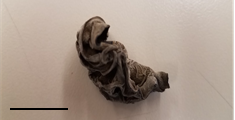 | Auricularia heimuer (Cloud Ear) |
| S2 | 2 February 2017 | Supermarket, Queens, NY | Shiitake (dried) | 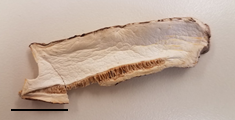 | Lentinula edodes (Shiitake mushroom) |
| S3 | 2 February 2017 | Supermarket, Queens, NY | Wood Ear (dried) | 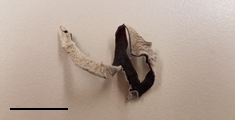 | No sequence |
| S4 | 2 February 2017 | Supermarket, Queens, NY | Oyster mushroom (dried) |  | Pleurotus sp. (Oyster mushroom) |
| S5 | 2 February 2017 | Supermarket, Queens, NY | White Button (dried) | 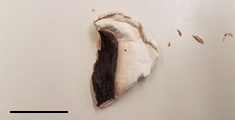 | Agaricus bisporus (White Button) |
| S6 | 2 February 2017 | Supermarket, Queens, NY | Unknown (dried) | 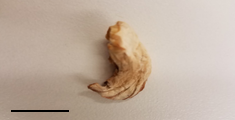 | Pleurotus sp. (Oyster mushroom) |
| S7 | 2 February 2017 | Supermarket, Queens, NY | White Button (fresh) |  | Agaricus bisporus (White Button) |
| S8 | 2 February 2017 | Supermarket, Queens, NY | Korean Black (dried) | 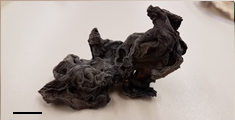 | Auricularia sp. (Wood Ear) |
| S9 | 24 February 2017 | Supermarket, Manhattan, NY | Yellow Foot (fresh) | 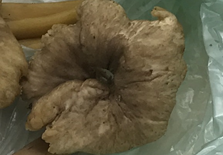 | Craterellus sp. (Chanterelle) |
| S10 | 24 February 2017 | Supermarket, Manhattan, NY | Yellow Foot (fresh) | 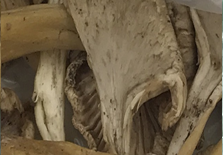 | Craterellus sp. (Chanterelle) |
| Sample | Fungal sp. Per Label | DNA Subway | BLAST, GenBank | UNITE | |||
|---|---|---|---|---|---|---|---|
| Barcode ID | % Match | Barcode ID | % Match | Barcode ID | % Match | ||
| S1 | Cloud Ear | Auricularia heimuer | 100 | Auricularia heimuer | 99 | Auricularia heimuer | 100 |
| S2 | Shiitake mushroom | Lentinula edodes | 100 | Lentinula edodes | 99 | Lentinula edodes | 100 |
| S3 | Wood Ear | N/A | N/A | N/A | N/A | N/A | N/A |
| S4 * | Oyster mushroom | Pleurotus ostreatus | 84 | Pleurotus sp. | 93 | Pleurotus sp. | 85 |
| S5 | White Button | Agaricus bisporus | 100 | Agaricus bisporus | 99 | Agaricus bisporus | 100 |
| S6 * | Oyster mushroom | Pleurotus sp. | 90 | Pleurotus sp. | 91 | Pleurotus sp. | 91 |
| S7 | White Button (fresh) | Agaricus bisporus | 100 | Agaricus bisporus | 100 | Agaricus bisporus | 100 |
| S8 | Korean Black | Auricularia sp. | 100 | Auricularia heimuer | 100 | Auricularia sp. | 100 |
| S9 | Yellow Foot (fresh) | Craterellus tubaeformis | 100 | Craterellus tubaeformis | 100 | Craterellus sp. | 100 |
| S10 | Yellow Foot (fresh) | Craterellus tubaeformis | 100 | Craterellus tubaeformis | 100 | Craterellus sp. | 100 |
© 2018 by the authors. Licensee MDPI, Basel, Switzerland. This article is an open access article distributed under the terms and conditions of the Creative Commons Attribution (CC BY) license (http://creativecommons.org/licenses/by/4.0/).
Share and Cite
Jensen-Vargas, E.; Marizzi, C. DNA Barcoding for Identification of Consumer-Relevant Fungi Sold in New York: A Powerful Tool for Citizen Scientists? Foods 2018, 7, 87. https://doi.org/10.3390/foods7060087
Jensen-Vargas E, Marizzi C. DNA Barcoding for Identification of Consumer-Relevant Fungi Sold in New York: A Powerful Tool for Citizen Scientists? Foods. 2018; 7(6):87. https://doi.org/10.3390/foods7060087
Chicago/Turabian StyleJensen-Vargas, Emily, and Christine Marizzi. 2018. "DNA Barcoding for Identification of Consumer-Relevant Fungi Sold in New York: A Powerful Tool for Citizen Scientists?" Foods 7, no. 6: 87. https://doi.org/10.3390/foods7060087





